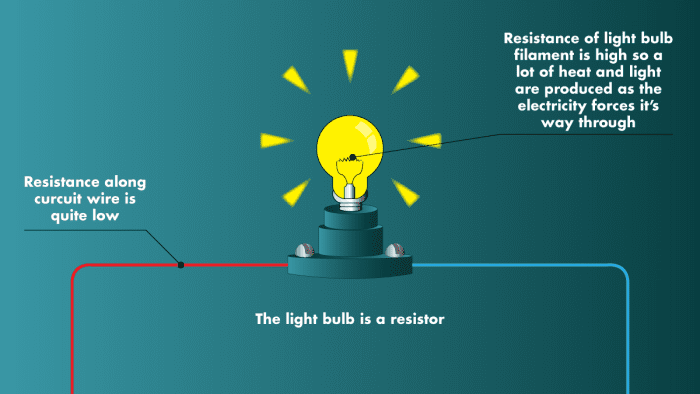How to Understand Electricity: Watts, Amps, Volts, and Ohms

A light bulb gets brighter as the power, measured in watts, increases. Unfortunately, bright ideas don't typically keep the lights on.
Basic Guide to Electricity
Welcome to your guide to the basics of electricity.
The four most basic physical quantities in electricity are:
- Voltage (V)
- Current (I)
- Resistance (R)
- Power (P)
Each of these quantities is measured using different units:
- Voltage is measured in volts (V)
- Current is measured in amps (A)
- Resistance is measured in ohms (Ω)
- Power is measured in watts (W)
Electrical power, or the wattage of an electrical system, is always equal to the voltage multiplied by the current.
A system of water pipes is often used as an analogy to help people understand how these units of electricity work together. In this analogy, voltage is equivalent to water pressure, current is equivalent to flow rate, and resistance is equivalent to pipe size.
In electrical engineering, there is a basic equation that explains how voltage, current, and resistance relate. This equation, written below, is known as Ohm's law.
Ohm's Law
V = I x R
Ohm's law states that voltage is equal to the current flowing in a circuit times the resistance of the circuit.
One way of understanding Ohm's law is to apply it to the imaginary plumbing system we've employed as a representation of an electrical system.
Let's say we have a tank of water attached to a hose. If we increase the pressure in the tank, more water will come out of the hose. Thus, if we increase the voltage in an electrical system, we will also increase the current.
If we make the diameter of the hose smaller, resistance will increase, causing less water to come out of the hose. Thus, if we increase the resistance in an electrical system, we will decrease the current.
With this brief introduction to the workings of an electrical system, let's jump into each of the units of electricity separately and learn about them in more detail.
Recommended
What Are Volts?
Volts are the base unit used to measure voltage. One volt is defined as the "difference in electric potential between two points of a conducting wire when an electric current of one ampere dissipates one watt of power between those points." The volt is named after the Italian physicist Alessandro Volta.
In our battery diagram above, the battery provides what is known as a potential difference in an electric circuit or voltage. If we go back to our water analogy, the battery is like a water pump that propels water through a pipe. The pump increases the pressure in the pipe, causing the water to flow.
In electrical engineering, we call this electrical pressure voltage and measure it in volts. A voltage of three volts can be written as 3V.
As the number of volts increases, the current increases too. But in order for the current to flow, the electrical conductor or wire must loop back to the battery. If we break the circuit, with a switch, for example, then no current will flow.
There are standard voltage outputs for everyday objects like batteries and household outlets. In the United States, the standard voltage output for a household outlet is 120V. In Europe, the standard voltage output for a household outlet is 230V. Other standard voltage outputs are listed in the table below.
Common Voltages
| Object | Voltage |
|---|---|
Single-cell, rechargeable battery | 1.2V |
Single-cell, non-rechargeable battery | 1.5V–1.56V |
USB | 5V |
Automobile battery | 2.1V per cell |
Electric vehicle battery | 400V |
Household outlet (Japan) | 100V |
Household outlet (North America) | 120V |
Household outlet (Europe, Asia, Africa, Australia) | 230V |
Rapid transit third rail | 600V–750V |
High-voltage electric power lines | 110,000V |
Lightning | 100,000,000V |
What Are Amps?
The ampere, often shortened to "amp" or A, is the base unit of electric current in the International System of Units. It is named after the French mathematician and physicist André-Marie Ampère, who is considered the father of electrodynamics.
Electricity consists of the flow of electrons through a conductor, for example, an electric wire or cable. We measure the rate of flow of electricity as an electric current (just as we think of the rate of flow of water in a river as the river current). The letter used to represent current in an equation is I.
Electric current is measured in Amperes, shortened to Amps or simply the letter A.
A current of 2 Amps can be written as 2A. The bigger the current, the more electricity flows.
The International System of Units (SI) defines amps as follows:
"The ampere is that constant current which, if maintained in two straight parallel conductors of infinite length, of negligible circular cross-section, and placed one metre apart in a vacuum, would produce between these conductors a force equal to 2×10−7 newtons per metre of length."
What Are Ohms?
Ohms are the base unit of resistance in an electrical system. The ohm is defined as "an electrical resistance between two points of a conductor when a constant potential difference of one volt, applied to these points, produces in the conductor a current of one ampere, the conductor not being the seat of any electromotive force." The ohm is named after the German physicist Georg Simon Ohm.
Resistance is measured in ohms, or Ω (omega), for short. So, five ohms can be written 5Ω.
In our battery diagram above, if we remove the bulb and reconnected the wire, so the battery was short-circuited, the wire and battery would get very hot, and the battery would soon be flat because there would be virtually no resistance in the circuit. Without any resistance, a huge electrical current would flow until the battery was empty.
Once we add a bulb to the circuit, resistance is created. There is now a local "blockage" (or narrowing of the pipe, per our water pipe analogy) where the current experiences some resistance. This greatly reduces the current flowing in the circuit, so the energy in the battery is released more slowly.
As the battery forces the current through the bulb, the battery's energy is released in the bulb in the form of light and heat. In other words, the current carries stored energy from the battery to the bulb, where it is turned into light and heat energy.
What Are Watts?
A watt is the base unit of power in electrical systems. It can also be used in mechanical systems. It measures how much energy is released per second in a system. In our battery diagram, the size of both the voltage and the current in the bulb determine how much energy is released.



